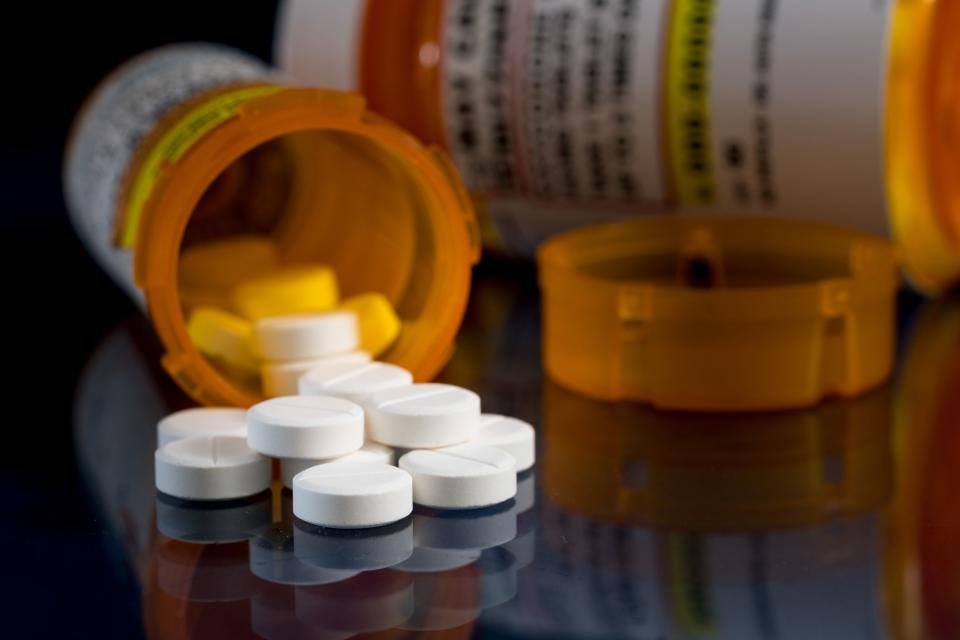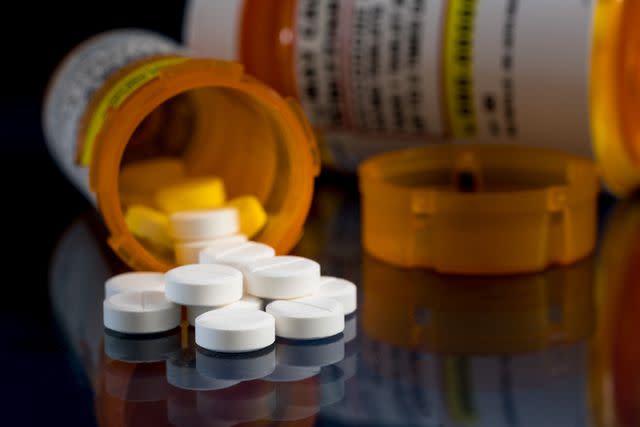What's the Difference Between Oxycodone and Hydrocodone?
Both are opioid painkillers with slightly different forms and side effects

BackyardProduction / Getty Images
Medically reviewed by Paria Sanaty Zadeh, PharmD
Hydrocodone and oxycodone are both opioid pain relievers. They’re available by prescription to treat moderate to severe pain, including that from cancer or recent surgery.
The medications have similar chemical structures, and they work by blocking certain receptors in the brain to change how the brain processes pain. While the medications are effective pain relievers, they also have the risk of tolerance, dependence, and addiction. This is why they are only used for a short period, unless prescribed for a chronic pain condition and closely monitored by a healthcare provider.
This article will compare hydrocodone vs. oxycodone. It will explain the difference between oxycodone and hydrocodone, which is stronger, their side effects, and more.

BackyardProduction / Getty Images
Oxycodone vs. Hydrocodone Differences
Learn about the differences and similarities of oxycodone and hydrocodone.
Uses of Oxycodone and Hydrocodone
Oxycodone and hydrocodone are both used to treat pain. They are usually only used when other pain treatments haven’t worked. That’s because both carry a serious risk of dependence and addiction.
A healthcare provider might prescribe these pain relievers if you have a severe injury like a broken bone, or if you’re recovering from surgery. People with painful, chronic conditions like cancer or sickle-cell disease may be prescribed oxycodone or hydrocodone as well.
Drug Class
Both oxycodone and hydrocodone are part of the same drug class. They are both Schedule II opioid or narcotic drugs. That means they have accepted medical uses (in this case, pain relief). However, they are also considered dangerous because they have a high potential for misuse and abuse. If you take either of these drugs for longer than a short period, you can become physically and psychologically dependent on them.
Forms and Dosage
If you’re comparing hydrocodone vs. oxycodone, it’s important to consider the forms and dosage. While your healthcare provider will help you determine the forms and dosage that are right for you, the information below may also be helpful.
Oxycodone
Oxycodone comes in the following six forms:
Liquid solution
A concentrated liquid solution
A tablet
A capsule
An extended-release tablet
An extended-release capsule
Your healthcare provider will start you on a low dose of oxycodone to begin with—usually 5 to 10 milligrams every four to six hours. Over time, your body may become accustomed to the drug, and you’ll need a higher dose to get the same amount of pain relief. This is one of the reasons they can cause dependence and potentially lead to abuse.
Hydrocodone
Hydrocodone is available as an extended-release capsule or tablet. The tablet is taken once daily, and the capsule is usually taken once every 12 hours. Most often, you’ll start on a low dose of hydrocodone, usually 5–10 milligrams per dose.
Hydrocodone is only available as an immediate-release product when combined with a non-opioid such as acetaminophen or ibuprofen. Some prescription cough syrups also combine immediate-release hydrocodone with antihistamines and decongestants.
Effectiveness
Both hydrocodone and oxycodone are considered effective pain relievers. One study of people who visited the emergency room for pain found that 50% of them had less pain when they were given hydrocodone or oxycodone.
Side Effects
Hydrocodone and oxycodone have similar side effects overall. Because they are depressants, both medications can cause drowsiness, sedation, respiratory depression, and death if taking too much or using them too frequently. For your safety, it's important not to drive a vehicle or operate machinery until you know how the medication affects you.
It's important to avoid taking opioids with alcohol. Always ask your healthcare provider if you're unsure how alcohol may interact with any medications you may be taking.
The common side effects of these medications are the same:
Constipation
Nausea
Headache
Stomach pain
Feeling tired or drowsy
Dizziness
When to Call Your Healthcare Provider
Both hydrocodone and oxycodone can have serious side effects. If you experience changes to heartbeat, have trouble breathing, develop hives, or experience other concerning symptoms call your healthcare provider immediately.
Risks
Both oxycodone and hydrocodone are considered to have serious risks. That is why they are classified as Schedule II drugs. It’s important to be aware of the risks and discuss them openly with your healthcare provider.
Addiction
The biggest risk of oxycodone and hydrocodone is addiction. Both drugs carry an important warning about their potential to be habit-forming. If you or any of your household members have a history of substance use disorder or addiction, have a candid conversation with your healthcare provider about whether oxycodone or hydrocodone are right for you.
People who misuse these drugs by taking them more often than prescribed are at risk for overdose. Symptoms of an overdose include:
Shallow, slow, or difficult breathing that may progress to stopping breathing
Sleepiness, progressing to an inability to respond or wake up
Slow heart rate that may progress to cardiac arrest
Muscle weakness
Cold, clammy skin
If you have a prescription for oxycodone and hydrocodone, talk to your healthcare provider about getting Narcan. This is an emergency nasal spray that can be used to reverse opioid overdose.
In March 2023, the Food and Drug Administration (FDA) approved Narcan Nasal Spray as an over-the-counter (OTC) emergency treatment for opioid overdose.
Drug Interactions
Oxycodone and hydrocodone have many drug interactions. You should tell your healthcare provider about any prescription drugs or supplements you take. You should also tell them about your alcohol use. They may recommend not drinking while you are taking oxycodone and hydrocodone.
The list of drugs that interact with oxycodone and hydrocodone is extensive. That’s why it’s important to tell your healthcare provider about all the medicines you’re taking. Here’s an overview of some common drugs that interact with oxycodone and hydrocodone:
Gabapentin
Sedatives such as benzodiazepines like Xanax (alprazolam) and Valium (diazepam)
Muscle relaxers
Medications used to help fall or stay asleep
Certain antibiotic, antiviral, or antifungal medications
Certain anti-seizure medications
Other opioid medications
Withdrawals
If you’ve been taking hydrocodone or oxycodone for a while, your body can become dependent on the medications. You should never stop taking them suddenly because if you do, you can experience withdrawal. Talk with your healthcare provider about how to safely stop taking painkillers.
Summary
Hydrocodone and oxycodone are opioid pain relievers used to treat moderate or severe pain. Both medications carry a serious risk for dependence and addiction. Because of that, they should only be used short term.
Before taking these medications, tell your healthcare provider about any medication you take, including vitamins and supplements. Talk about your alcohol use and how to safeguard yourself against opioid overdose.
Frequently Asked Questions
Which is stronger, oxycodone or hydrocodone?
Studies show that the two medications provide similar pain relief. Hydrocodone doses are taken less often, but when taken as prescribed, these drugs have similar strengths.
Is hydrocodone the same as oxycodone?
Hydrocodone and oxycodone are extremely similar. They are both synthetic opioid pain relievers that work by changing how the brain and neurological system process pain.
What are some alternatives to opioids for pain relief?
There are many options for non-opioid pain relief. These include nonsteroidal anti-inflammatory drugs (NSAIDs) like Advil (ibuprofen), Tylenol, antidepressants, anticonvulsants, physical therapy, cognitive therapy, and more.
Correction - June 22, 2023: The article was updated to include immediate-release hydrocodone formulations.

